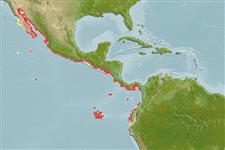>
Clupeiformes (Herrings) >
Engraulidae (Anchovies) > Engraulinae
Etymology: Cetengraulis: Greek, ketos = a marine monster, whale + Greek, eggraulis, -eos = anchovy (Ref. 45335).
More on author: Günther.
Environment: milieu / climate zone / depth range / distribution range
Écologie
marin; saumâtre; non migrateur; profondeur 0 - 32 m (Ref. 96339). Subtropical; 32°N - 4°S, 115°W - 78°W (Ref. 54323)
Eastern Pacific: southwestern coast of Baja California, Mexico and from the Gulf of California to northern Peru (up to the Bay of Sechura). Apparently reaching Los Angeles, USA, but these are perhaps releases from tuna boats.
Length at first maturity / Taille / Poids / Âge
Maturity: Lm 12.9, range 12 - ? cm
Max length : 22.0 cm TL mâle / non sexé; (Ref. 96339); common length : 12.0 cm SL mâle / non sexé; (Ref. 9298); âge max. reporté: 3 années (Ref. 905)
Épines dorsales (Total): 0; Épines anales 0; Rayons mous anaux: 17 - 24. Head large and deep. Snout short and pointed, about 2/3 eye diameter; maxilla moderate, tip blunt, just failing to reach lower jaw articulation; lower gill rakers fine and numerous, increasing in large fishes; no gill rakers on posterior face of third epibranchial. Branchiostegal rays 8, long and slender; branchiostegal membrane broad. Silver stripe disappearing at about 8-10 cm SL.
Occurs inshore, principally over mud flats and forming quite large schools. Apparently not making long migrations along sandy or rocky areas. Juveniles feed principally on diatoms, also silico-flagellates, dinoflagellates and small crustaceans; adults also mainly on benthic diatoms. Used as tuna baitfish. Processed into fishmeal and oil.
Whitehead, P.J.P., G.J. Nelson and T. Wongratana, 1988. FAO Species Catalogue. Vol. 7. Clupeoid fishes of the world (Suborder Clupeoidei). An annotated and illustrated catalogue of the herrings, sardines, pilchards, sprats, shads, anchovies and wolf-herrings. FAO Fish. Synop. 125(7/2):305-579. Rome: FAO. (Ref. 189)
Statut dans la liste rouge de l'IUCN (Ref. 130435)
Menace pour l'homme
Harmless
Utilisations par l'homme
Pêcheries: hautement commercial; appât: usually
Plus d'informations
RéférencesAquacultureProfil d'aquacultureSouchesGénétiqueElectrophoresesHéritabilitéPathologiesTraitementNutrientsMass conversion
CollaborateursImagesStamps, Coins Misc.SonsCiguateraVitesseType de nageSurface branchialeOtolithesCerveauxVision
Outils
Articles particuliers
Télécharger en XML
Sources Internet
Estimates based on models
Preferred temperature (Ref.
123201): 22.3 - 29.1, mean 25.9 °C (based on 231 cells).
Phylogenetic diversity index (Ref.
82804): PD
50 = 0.7500 [Uniqueness, from 0.5 = low to 2.0 = high].
Bayesian length-weight: a=0.00513 (0.00308 - 0.00854), b=3.25 (3.11 - 3.39), in cm total length, based on LWR estimates for this species & (Sub)family-body (Ref.
93245).
Niveau trophique (Ref.
69278): 2.5 ±0.21 se; based on food items.
Résilience (Ref.
120179): Haut, temps minimum de doublement de population inférieur à 15 mois (K=0.9-2.6; tm=1; tmax=4).
Prior r = 0.96, 95% CL = 0.64 - 1.44, Based on 3 stock assessments.
Fishing Vulnerability (Ref.
59153): Low vulnerability (19 of 100).
Climate Vulnerability (Ref.
125649): Moderate vulnerability (40 of 100).
Nutrients (Ref.
124155): Calcium = 176 [104, 434] mg/100g; Iron = 2.28 [1.19, 4.07] mg/100g; Protein = 19.6 [18.1, 21.1] %; Omega3 = 0.642 [0.347, 1.276] g/100g; Selenium = 23.1 [10.8, 49.1] μg/100g; VitaminA = 5.29 [1.40, 16.98] μg/100g; Zinc = 1.63 [1.12, 2.52] mg/100g (wet weight);
